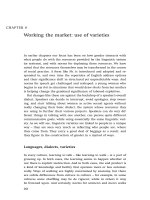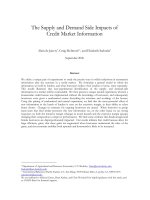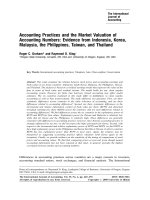Waldfogel the tyranny of the market; why you cant always get what you want (2007)
Bạn đang xem bản rút gọn của tài liệu. Xem và tải ngay bản đầy đủ của tài liệu tại đây (473.35 KB, 217 trang )
The Tyranny of the Market
The Tyranny of the Market
WHY YOU CAN’T ALWAYS GET WHAT YOU WANT
Joel Waldfogel
Harvard University Press
Cambridge, Massachusetts
London, England
2007
Copyright © 2007 by the President and
Fellows of Harvard College
All rights reserved
Printed in the United States of America
Library of Congress Cataloging-in-Publication Data
Waldfogel, Joel, 1962–
The tyranny of the market : Why you can’t always get what
you want / Joel Waldfogel.
p. cm.
Includes bibliographical references and index.
ISBN-13: 978-0-674-02581-3
ISBN-10: 0-674-02581-4
1. Consumers’ preferences. 2. Majorities. 3. Supply and
demand. 4. Social choice. 5. Free enterprise. I. Title.
HF5415.32.W35 2007
381—dc22
2007000531
Contents
Preface
Introduction
vii
1
PART ONE
THEORY
1 Markets and the Tyranny of the Majority
13
2 Are “Lumpy” Markets a Problem?
21
PART TWO
EMPIRICAL EVIDENCE
3 Who Benefits Whom in Practice
39
4 Who Benefits Whom in the Neighborhood
59
5 Preference Minorities as Citizens and Consumers
74
PART THREE
MARKET SOLUTIONS AND THEIR LIMITS
6 Market Enlargement and Consumer Liberation
89
7 Fixed Costs, Product Quality, and Market Size
100
8 Trade and the Tyranny of Alien Majorities
108
9 Salvation through New Technologies
119
vi
•
Contents
PART FOUR
POLICY SOLUTIONS AND THEIR LIMITS
10 Government Subsidies and Insufficient Demand
131
11 Books and Liquor: Two Case Studies
147
Conclusion
163
Notes
173
References
189
Credits
195
Index
197
Preface
In this book, I respond to—and extend in new ways—ideas laid out
most famously in two very important works in economics and political economy, Milton Friedman’s Capitalism and Freedom and
John Stuart Mill’s On Liberty. Mill points out a fundamental feature of decision-making through government, that majority rule imposes constraints on individuals who disagree with the collective
choice. My liberty is abridged in the sense that the choices available
to me as a citizen depend on the preferences of others. If the majority wants liquor stores closed on Sunday while I would prefer to
have them open, then my freedom is abridged by the fact that we
make this choice collectively. If I want green shirts but the state
shirt-making collective, bowing to majority views, makes only red,
then my freedom to choose among shirt colors is abridged.
Friedman agrees that allocation through collective choice promotes a tyranny of the majority, and he argues that when allocation
takes place through markets, rather than collective choice, individuals get what they want rather than, say, what the majority wants.
Friedman argues for a stark dichotomy between market and collective choice. Markets offer “freedom” in the sense of allowing people access to whatever products might suit their tastes, regardless of
what others prefer. On this basis he argues that societies should let
the market decide as many questions as possible to avoid effects
akin to tyranny of the majority.
viii
•
Preface
As a student I read both Capitalism and Freedom and On Liberty
with great interest. Capitalism and Freedom inspired me with the
message that allocation through markets is not just expedient; it
also promotes freedom, something far nobler than base material
needs. I often claimed to incredulous acquaintances that Capitalism
and Freedom would still be read centuries from now.
I still view Friedman’s book as an enduring contribution, but for
more than a decade I have been an empirical economist studying
the functioning of actual markets. In the course of my research I
have discovered a (growing) number of contexts in which people’s
consumption options—and indeed their ensuing satisfaction as consumers—depend on the preferences of others. In particular, in markets where fixed costs are substantial and preferences differ across
groups of consumers, individuals find more options—and more satisfaction—when more people share their preferences. That is, I have
documented phenomena analogous to the tyranny of the majority
in markets. These findings stand in stark contrast to the notion that
markets avoid objectionable features of collective choice.
My goal in this work is not so much to argue that Friedman is
wrong. To the extent that Friedman is arguing that capitalism allows better tailoring of consumption opportunities to heterogeneous preferences than, say, a communist system of state-run industry, he is surely correct. Rather, my goal is to demonstrate that
Friedman’s dichotomy between markets and collective choice is not
right. Under some simple circumstances that prevail in many markets, what I get depends on how many others also want it. Market
allocation shares many of the features of allocation through collective choice. This finding—which is the chief message of the book—
undermines some of the rationale to let the market decide such a
wide array of questions.
When I first began talking about these ideas in seminars in the
late 1990s, one prominent economist told me, “That’s interesting.
But aren’t you worried about what the Right would do with those
Preface
•
ix
results?” This economist was presumably concerned that conservatives would see in the results an argument for promoting residential segregation. For example, clusters of blacks would bring forth
products more appealing to blacks, relieving pressure for policies
promoting residential mobility by minorities. A week later, another
prominent economist had a similar but opposite reaction, finding it
“interesting” but expressing concern about “what the Left would
do with the results.” This economist was presumably concerned
that activists would see an argument for subsidizing products targeted at minorities and other small groups of consumers. Annoying
people across the ideological spectrum confirmed my sense that I
was on to something. This book is the result.
This book is the distilled product of ten years of work, much of
it undertaken with students and colleagues, to whom I am enormously grateful. Collaborators who helped educate me include
Steve Berry, Lisa George, Felix Oberholzer-Gee, Peter Siegelman,
and Todd Sinai. I have benefited from comments on the book draft
from my editor at Harvard University Press, Mike Aronson, as well
as Mary Benner, Steve Berry, Matt Kahn, Jeff Milyo, Fiona ScottMorton, Asher Waldfogel, and two anonymous referees.
I am grateful for the intellectual atmosphere of the Wharton
School, where I have been free to pursue empirical applied economics informed by heavy doses of reality. I am also grateful for the
hospitality of the Wharton Marketing Department during a leave in
the fall of 2005, when I completed a draft of the manuscript.
This book is dedicated to three sets of people who have been
instrumental in my life and work: my wife, Mary Benner, an accomplished scholar who has supported this project from before its
beginning; my father, Melvin, and late mother, Gertrude, whose
rearing made me sensitive to the concerns of preference minorities;
and my children, Hannah and Sarah, who inspire me every day.
The Tyranny of the Market
Introduction
Societies need to make decisions about material questions, such as
what to produce and who gets what; broadly, these decisions can be
made either through political processes such as voting or through
voluntary arrangements among individuals in markets. Choices
made through voting result in “laws” that apply to everyone. Whatever decision the group makes, everyone must obey. Laws have
some disadvantages, which can be illustrated by an imaginary town
meeting. Will the town square be a playground or a shopping mall?
Only one outcome is possible; the space cannot be both. Suppose
that 55 percent of the people want the shopping mall. After three
hours of impassioned speeches by parents of small children, who
want the playground, and shoppers, who want the mall, there is a
vote. The mall wins, and the town square will become a mall. After
the meeting, 55 percent of the voters go home happy, while the
other 45 percent go home dissatisfied. With majority rule, those in
the majority are winners, while those in the minority are losers.
This is an example of what the nineteenth-century English political
philosopher John Stuart Mill called the “tyranny of the majority.”
With some questions—will abortion be legal, how much will we
spend on national defense—society must come to a single answer.
Unless all people agree, the answer will upset some, and there will
be tyranny of the majority.
1
2
•
Introduction
A dominant strand of current thinking holds that markets are
distinctly different from, and superior to, government as means of
allocation. Markets are thought to avoid the tyranny of the majority because in markets each person can decide what she wants. Milton Friedman’s 1962 landmark book Capitalism and Freedom puts
it this way: the “characteristic feature of action through political
channels is that it tends to require or enforce substantial conformity. The great advantage of the market, on the other hand, is that
it permits wide diversity. It is, in political terms, a system of proportional representation. Each man can vote, as it were, for the color of
tie he wants and get it; he does not have to see what color the majority wants and then, if he is in the minority, submit” (p. 15).
The statement that “each man can vote . . . for the color of the tie
he wants and get it” bears repeating. It is a statement that what’s
available to me in markets depends only on my preferences, not on
anyone else’s. This rationale has stood for years as a compelling argument bolstering calls to “let the market decide” a wide variety of
questions and for moving allocation decisions outside of the messy
political sphere, where others’ preferences inhibit my options, and
into the pure economic one. But do markets really liberate consumers from their neighbors’ tastes? And do they avoid problems akin
to tyranny of the majority that are endemic to allocation through
government?
An extended example raises some questions: Try driving across
the United States with only a car radio for entertainment. In remote locations you may receive no radio stations at all. As you
drive through small towns, you will receive a few stations, perhaps one broadcasting country music and another airing “fire and
brimstone” religious programming. Scanning the dial as you drive
through an urban area of one million people, you will find twenty
to twenty-five stations broadcasting in about fifteen distinct programming formats, including Top 40, oldies, adult contemporary,
classic rock, alternative rock, and perhaps jazz and classical. When
Introduction
•
3
you get to New York or Los Angeles, you will be able to receive as
many as fifty different radio stations. In short, larger markets support more—and generally a wider variety—of products. More people will find an option they find attractive when more products are
available. In this sense, people benefit each other in markets by
helping to make additional products profitable and therefore available. Yet it is clear that in this market, as when voting, my preferences alone do not determine what’s available to me.
There is more to the story than a simple bigger-is-better argument, however. Suppose you prefer radio programming in Spanish.
Remote locations will offer you no options in either English or
Spanish. As you tour the country, you will find Spanish-language
programming in most major urban areas, but the places with the
most Spanish programming will not be the largest urban areas.
Rather you will find the greatest variety of Spanish-language stations in the metro areas with the largest Hispanic populations. The
McAllen-Brownsville, Texas, area, for example, with an overall
population of about 650,000 in 1997, had seventeen local radio
stations, eight of them broadcasting in Spanish. By contrast, the
Tulsa, Oklahoma, metro area, roughly equal in size, had twentyone local stations, all of them broadcasting in English. This comparison demonstrates that your satisfaction as a consumer depends
not simply on market size but more specifically on the number of
persons who share your preferences. I call this the “who benefits
whom” phenomenon. By making it profitable for firms to offer
more Spanish-language stations, additional Hispanics benefit other
Hispanics. But, as in this example, they need not benefit English
speakers, and English speakers need not benefit them.
These simple examples challenge the supposed stark distinction
between markets and collective choice. Listeners’ options on the radio dial, and their ensuing satisfaction with those options, depend
not only on their preferences, but also on the prevalence of their
preferences in the potential market. You will find products that suit
4
•
Introduction
you only if enough others also want the product. If you are alone,
or nearly alone, in your preference for some product, it will not be
made available. This mechanism is a mild market analogue to the
widely acknowledged tyranny of the majority in voting.
The “who benefits whom” phenomenon is by no means confined
to radio broadcast markets. Let’s rejoin the cross-country driving
tour. Suppose you like Afghan food, and your traveling companion
likes hamburgers. Because many Americans like hamburgers, your
friend will find appealing options essentially anywhere there is sufficient population concentration to support a restaurant. You, by
contrast, will find an appealing Afghan option only in huge cities,
because these cities are the only places with enough fans of Afghan
cuisine to make an Afghan restaurant profitable. Your friend will
always find satisfaction at mealtime, while you rarely will. Substitute kosher, halal, peanut-allergic, or Vietnamese for Afghan as
your culinary preference, and you can tell a similar story.
So far it’s clear that you can be better off in your capacity as a
consumer of a particular product as more consumers share your
preferences. The situation outlined is not a tyranny of the majority
per se. You are helped by additional persons who agree with you;
and while persons with different preferences do not help you, they
do not harm you either. But the story need not end here. Think of
product categories such as daily newspapers, in which there are
very few products per metropolitan area, and often just one. In this
case, the single product can be positioned to appeal to one group or
another. As one group grows larger, the product moves toward the
growing group to suit its needs and attract more of them as buyers.
This shift makes members of the growing group better off, but
members of the other group worse off, since the product is moving
further from what they like. If there is a single product whose appeal depends on its positioning, then consumers are better off as
more people agree with them and worse off as more people disagree. Not only do more people with my tastes help me, but also
Introduction
•
5
more people with different preferences can hurt me. This is the tyranny of the market, the product-market analogue to the conventional tyranny of the majority in voting. Just as the minority leaves
the town meeting unhappy with the majority choice, people whose
ideal product is far from the sole product’s positioning are hurt by
others with different preferences.
This argument is not just about obscure or unimportant markets or about hypothetical or arbitrary groups (such as Afghan food
lovers). Instead, only two broad features are required for markets
to share the fractious features of allocation through politics, in
which groups are pitted one against another. First, preferences
must differ across groups. And second, something—generally fixed
costs—must limit the number of available options and prevent
products from being provided to small groups of potential buyers.
The United States has been described as a “melting pot,” as a nation of immigrants, as a pluralistic society. Whatever one’s preferred metaphor, the United States surely has a diverse population
of people with different preferences about many policies and products. About 13 percent of the 275 million persons in the United
States are black, and 13 percent are Hispanic.1 As I will document
later, preferences for many products differ sharply between blacks
and whites and between Hispanics and non-Hispanics. In the standard view of the economy, people of diverse preferences would find
what they want regardless of the popularity of their choices. But
if the view I am advancing in this book is correct, then blacks,
Hispanics, and other “preference minorities”—that is, small groups
of people with atypical preferences—will see fewer appealing products and will be less satisfied than the majority as consumers and as
citizens.
Anyone can be a preference minority. Most people have unusual
tastes in some products, say for butter-brickle ice cream or for
grapefruit-flavored soft drinks. But some preference minorities can
be defined before the fact by ethnicity, culture, or biology—factors
6
•
Introduction
that can lead to different product needs. For these ex ante preference minorities, preferences may be less of an elective choice than
for those preferring butter brickle. For example, Hispanics speak a
different language than most other people in the United States,
leading to a preference for media products in Spanish. Orthodox
Jews and Muslims have dietary rules that give rise to a strong preference not to eat pork. Celiacs cannot consume gluten, giving rise
to very different food needs. People with peanut or seafood allergies
also prefer different foods. In all of these cases, the word “preference” is an understatement, since it implies more choice than may
be feasible.
The main point of this book is that the supposed dichotomy between markets and politics is not generally correct. While there are
some circumstances in which one’s satisfaction does not depend on
other consumers’ preferences—so that the dichotomy between markets and politics holds—there are many important situations in
which one consumer’s satisfaction does depend on others. In these
markets—as in politics—the happiness of consumers will depend
not just on their own preferences, but also on the prevalence of
their preferences. In short, the market does not generally avoid the
tyranny of the majority. In spite of the liberation rhetoric often used
to describe the market, the same kinds of groups disadvantaged by
majority rule—small groups with different preferences—can find
themselves at a disadvantage in product markets as well. This raises
a challenge to the common exhortation “Let the market decide.”
The first part of this book lays out the ideas. Chapter 1 describes, with intuitive examples, the circumstances in which markets produce effects similar to the tyranny of the majority. These
effects include more (or more appealing) products for larger consumer groups, greater consumer satisfaction for larger groups, and
in some instances harmful effects of one group’s size on the satisfac-
Introduction
•
7
tion of other groups of consumers. Chapter 2 asks whether the fact
that markets can share features of political allocation is, on close inspection, undesirable. When fixed costs are large and preferences
differ across consumers, do markets achieve desirable outcomes?
Are they efficient? Are they fair?
Part II presents empirical evidence on several specific industries
that share the features of large fixed costs and preferences that differ across consumers. Using blacks and whites, and Hispanics and
non-Hispanics, as groups, and pointing to local media markets as a
major example, I show, first, that preferences differ sharply across
groups. Second, I demonstrate that product targeting is sensitive to
group size. Finally, I document that consumption, and satisfaction
with the products, is higher as groups are larger. Chapter 3 illustrates the “who benefits whom” phenomenon with evidence on radio broadcasting and illustrates the more extreme tyranny of the
majority with data on the daily newspaper industry. Chapter 4
shows that the “who benefits whom” phenomenon also operates at
the neighborhood level in the restaurant industry.
For many products, consumption is an end in itself. For others,
including information products such as newspapers and broadcasting, consumption is a means to other ends, such as knowing how
and whether to participate in civic affairs. Chapter 5 provides an
important extension on how the availability of group-targeted
media products affects whether the targeted individuals vote. The
chapters of Part II collectively show that just as my welfare as a citizen is limited by my neighbors’ political preferences, my welfare as
a consumer is limited by my neighbors’ product preferences. Moreover, my neighbors’ preferences for media products affect how easily I can become informed, a process that reinforces the political advantage of large groups.
Having outlined the problem—that markets share features of collective choice—I move in Part III to a discussion of possible solutions. The most obvious market-based solution to a problem cre-
8
•
Introduction
ated by large fixed costs in relation to market size is larger markets.
Products created for a national rather than a local market, and
that are “traded” across regions, allow a test for whether market
size is a liberating force. Chapter 6 shows that trade is a liberating
force for isolated consumers. The Internet and cable television are
illustrative examples of new technologies that allow information
trading across places, thereby increasing the number of other likeminded consumers who can support products that each person prefers. For example, blacks in more predominantly white metropolitan areas use the Internet more than less-isolated blacks, showing
that market enlargement provides some liberation from neighbors’
tastes.
But the extent of liberation available from larger markets is limited. Larger markets generally beget more (and more varied) products, but in some industries, larger markets beget products that are
bigger and better for many but not all consumers. Chapter 7 illustrates these possibilities using the contrast between the restaurant
industry, where the quantity and variety of products grows with the
size of the market, and the daily newspaper industry, where the size
rather than the number of products grows with market size. Chapter 8 examines some subtleties that arise with trade in high fixed
cost products. Although trade generally increases the number of options available to consumers, trade can also cause a repositioning of
products, bringing about a “tyranny of alien majorities.” For example, imported products can draw customers from local products,
forcing local products to reposition if they are to continue covering
fixed costs. This can benefit some consumers while harming others.
Chapter 9 discusses technological changes as a source of liberation,
with a series of examples.
Parts II and III provide empirical evidence that market allocation
shares some of the objectionable features of collective choice. Even
if markets are imperfect, it is not always clear whether the alternatives would be better. Part IV presents some discussion of policy re-
Introduction
•
9
sponses to perceived shortcomings in markets. Chapter 10 reviews
U.S. policies to subsidize the provision of high fixed cost products to small populations, including air transport, radio broadcasting, telecommunications, electricity, and pharmaceutical products.
Chapter 11 provides a direct comparison of market and government provision of two products (books and liquor), both widely
distributed by both government entities and private firms. The
chapter then brings up the question of what sort of consumers
benefit from the decision to allocate through markets rather than
through government.
Please note that most of the chapters of the book are based on academic articles published in leading economics journals. Economic
theory guides the questions, and systematic analysis of data allows
the questions to be answered. To make the book as readable as possible, I have omitted much of the technical discussion. A reader interested in technical arcana is encouraged to consult the underlying
academic articles, which are cited at places that invoke their arguments or evidence.
PART ONE
THEORY









